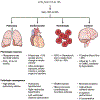Hypoxia as a medicine
- PMID: 39841808
- PMCID: PMC12342338
- DOI: 10.1126/scitranslmed.adr4049
Hypoxia as a medicine
Abstract
Oxygen is essential for human life, yet a growing body of preclinical research is demonstrating that chronic continuous hypoxia can be beneficial in models of mitochondrial disease, autoimmunity, ischemia, and aging. This research is revealing exciting new and unexpected facets of oxygen biology, but translating these findings to patients poses major challenges, because hypoxia can be dangerous. Overcoming these barriers will require integrating insights from basic science, high-altitude physiology, clinical medicine, and sports technology. Here, we explore the foundations of this nascent field and outline a path to determine how chronic continuous hypoxia can be safely, effectively, and practically delivered to patients.
Conflict of interest statement
VKM is listed as an inventor on patents owned by Massachusetts General Hospital on therapeutic uses of hypoxia (“Compositions and methods that promote hypoxia or the hypoxia response for the treatment and prevention of mitochondrial dysfunction and oxidative stress disorders”: US-20190015444-A1, US-10842812-B2, US-20210093660-A1. “Methods to treat mitochondrial-associated dysfunctions or diseases”: US-20220096541-A1.). VKM is a paid advisor to 5AM Ventures. RSR was previously employed by Vertex Pharmaceuticals and is currently employed by Tectonic Therapeutic; neither company had any role in the writing of this manuscript.
Figures


References
-
- Rusina PV, Falaguera MJ, Romero JMR, McDonagh EM, Dunham I, Ochoa D, Genetic support for FDA-approved drugs over the past decade. Nat Rev Drug Discov 22, 864 (2023). - PubMed
-
- Jacobs SS, Lederer DJ, Garvey CM, Hernandez C, Lindell KO, McLaughlin S, Schneidman AM, Casaburi R, Chang V, Cosgrove GP, Devitt L, Erickson KL, Ewart GW, Giordano SP, Harbaugh M, Kallstrom TJ, Kroner K, Krishnan JA, Lamberti JP, Porte P, Prieto-Centurion V, Sherman SE, Sullivan JL, Sward E, Swigris JJ, Upson DJ, Optimizing Home Oxygen Therapy. An Official American Thoracic Society Workshop Report. Ann Am Thorac Soc 15, 1369–1381 (2018). - PubMed
-
- Biggs AT, Littlejohn LF, Dainer HM, Alternative Uses of Hyperbaric Oxygen Therapy in Military Medicine: Current Positions and Future Directions. Mil Med 187, e40–e46 (2022). - PubMed
Publication types
MeSH terms
Substances
Grants and funding
LinkOut - more resources
Full Text Sources

